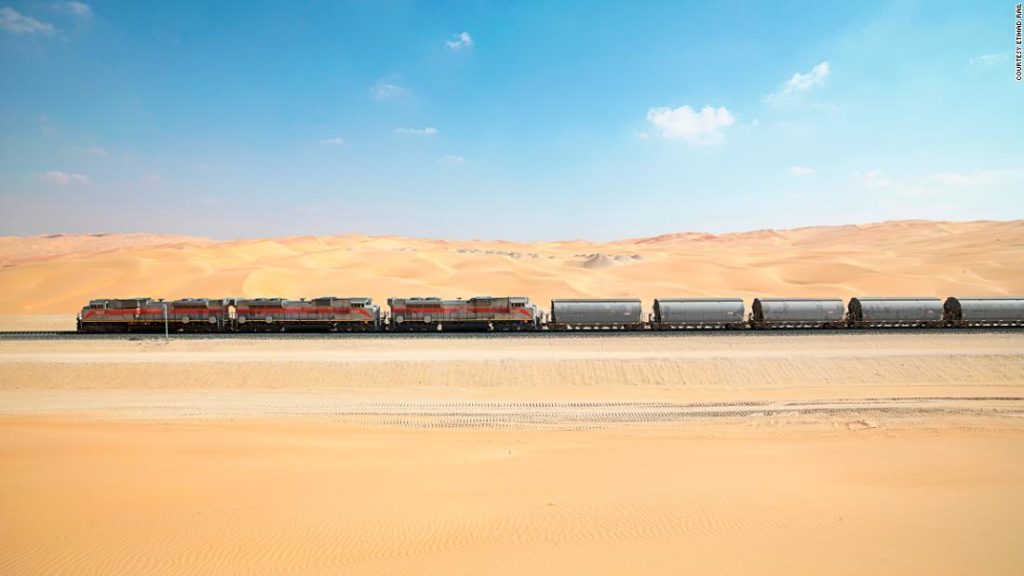(CNN) — In the Hajar Mountains between Dubai and Fujairah, engineers are blasting out a new frontier for the United Arab Emirates. Ton by ton, rock is making way for 16 kilometers of tunnel, which will one day see trains barreling through it on a journey from coast to coast, and potentially further afield.
A nation known for its love of cars, as well as its strategic ports and airports, the UAE is betting big on its first national rail network. The 1,200-kilometer (746-mile) artery will connect the Gulf of Oman to the Persian Gulf, down through the emirates, into Abu Dhabi’s interior and to Ghuweifat on the border of Saudi Arabia, a key step in a long-mooted rail network crossing the Arabian peninsula.
“The top line implication … is that it has the potential to transform the UAE economy — and not just the UAE, but potentially the GCC [Gulf Cooperation Council],” says Richard Thompson, editorial director of the Middle East Economic Digest.
The diesel rail line could save 2.2 million metric tons of greenhouse gas emissions annually through its freight capacity alone, says the developer — the equivalent, it says, of taking 375,000 vehicles off the road. It has the potential to electrify in the future, which would further cut emissions if it uses renewable energy.
“I think rail has a huge role to play in helping the UAE reduce its carbon footprint,” says Thompson. “Rail can provide a much more efficient mode of transport for goods and people movement around cities; it can help your cities function better.”

Construction workers creating one of 15 tunnels that will run between the Port of Fujairah and the Dubai border of Sharjah.
courtesy Etihad Rail
“You have a more efficient mode of transport, linking ports with each other and removing congestion on the roads and contributing to decarbonization,” he explains.
Ahmed Al Musawa, executive director of commercial at Etihad Rail, anticipates 60 million metric tons of freight will move from road and sea to the rail network annually.

A photograph of a train running along stage one of the network, connecting gas fields to the port of Ruwais in Abu Dhabi.
courtesy Etihad Rail
As well as consolidating the UAE’s position as an international transport hub, there are benefits at a national level too, Al Musawa argues. Stage one of the network in Abu Dhabi — 264 kilometers (164 miles) of line connecting gas fields in Shah and Habshan and the port of Ruwais — has transported 33 million metric tons of sulfur since 2016, he says, and turned the UAE into the world’s largest exporter of the element, used in the manufacture of everything from fertilizer to paper.
Stage two, which stretches 605 kilometers (376 miles) and began construction earlier this year, could have wider benefits.
Kevin Smith, editor in chief of the International Railway Journal, identifies the railway as a “key strategy … to diversify (the UAE’s) economy slightly away from oil and gas.”
“I think the steel industry, oil and gas industry, then the mining and quarrying industry, should be the main beneficiaries,” says Thompson. “(The network) has the potential to integrate the northern emirate economies much closer into the national economy and accelerate growth and investment in those places.”
Can a nation of auto lovers switch lanes?
How the network will touch the daily lives of the UAE’s population remains to be seen. Passenger trains running at 200 kilometers per hour (124 miles per hour) are touted by Etihad Rail, but a date for passenger capacity is yet to be announced. If the network follows through, it could change commuting forever.

A section of the Sheikh Zayed Road, a key commuter route in Dubai, photographed July 2020.
KARIM SAHIB/AFP/AFP via Getty Images
“When you have direct, fast access, naturally that does change the way we perceive (distance), or we select where we live or work or study,” Al Musawa says. “The access to materials, services and markets can evolve around such a network.”
So will this new network convince Emiratis to swap their cars for trains? There are some obstacles, says Thompson, including the “last mile problem” — getting people from their homes to train stations.
Walking in the summer heat isn’t an attractive option, but Al Musawa says ride sharing and “other micro mobility solutions” may be the answer, adding Etihad Rail is learning from other countries’ experiences.
“I think there’ll be great demand,” Smith argues. “Their whole cities are built around the car, but I think the popularity of the metro (in Dubai) has shown that people will use it if it’s there.”
You may also like
-
UK coronavirus variant has been reported in 86 countries, WHO says
-
NASA technology can help save whale sharks says Australian marine biologist and ECOCEAN founder, Brad Norman
-
California Twentynine Palms: Explosives are missing from the nation’s largest Marine Corps base and an investigation is underway
-
Trump unhappy with his impeachment attorney’s performance, sources say
-
Lunar New Year 2021: Ushering in the Year of the Ox

